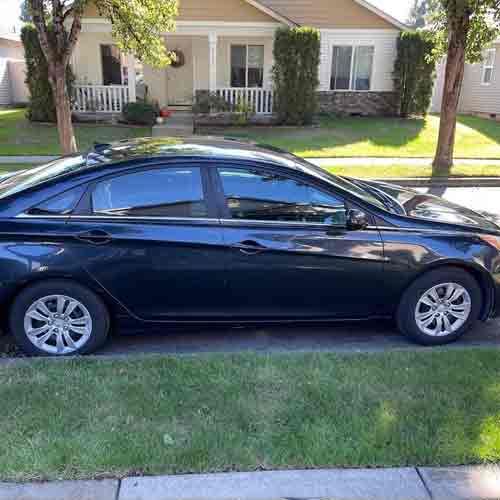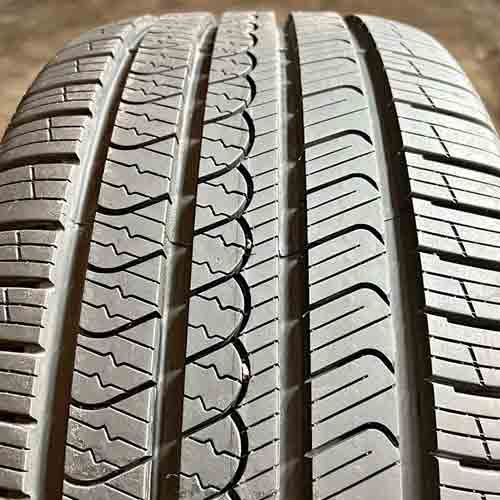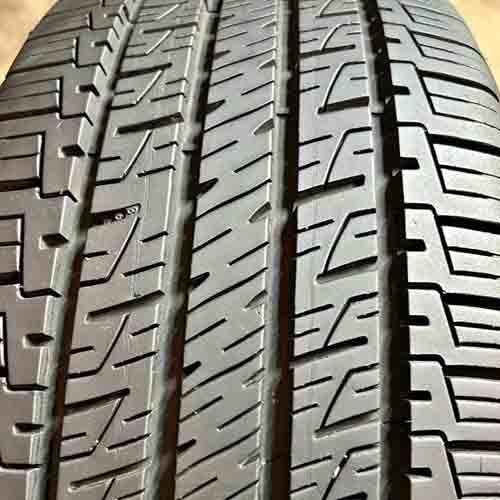In the world of all-season tires, the Pirelli Scorpion AS Plus 3 and Goodyear Assurance MaxLife shine bright. Tailored for a range of vehicles, these tires emphasize comfort, extended tread life, and consistent all-season performance, even in light snow. Let’s check them out in greater details.

My testing as a tire engineer reveal that the Goodyear MaxLife offers superior dry braking, cornering, tread wear, and fuel efficiency. In contrast, the Pirelli Scorpion AS Plus 3 excels in wet and winter traction and provides a smoother ride, though it’s noisier and less durable than the MaxLife.
Table of Contents
Diverse Sizing and Specs
On the other side, the Pirelli Scorpion AS Plus 3 comes in 17 to 22 inches wheels. And all of those sizes have following specifications.
- Speed ratings: T, H and V.
- Load ratings: SL and XL.
- Tread depth: 11/32″ on all.
- Weight range: 29 to 42 lbs.
- Treadwear warranty: 70k miles.
- UTQG rating: 800 A A.
Review this tire in greater details: https://tiredriver.com/pirelli-scorpion-as-plus-3-review/
The Goodyear Assurance MaxLife comes in 15 to 20 inches wheels, and all of those sizes have following specs.
- Speed ratings: H and V.
- Load ratings: SL and XL.
- Tread depth range: 11 to 12/32″.
- Weight range: 20 to 36 lbs.
- Treadwear warranty: 85k miles.
- UTQG rating: 820 A B.
Review this tire in greater details: https://tiredriver.com/goodyear-assurance-maxlife-review/
Tread Structure
The Pirelli Scorpion comes with an asymmetric tread pattern, with multiple design elements aimed at maximizing performance, comfort, and safety.

Now the whole structure is comprised of 5 ribs, where the 3 central ribs combined with 2 outer ones, form 4 circumferential channels in the middle.
The central most rib carries an array of curved (thick) slits, separating linear sipes from the wave-like pattern ones.
Basically, while the central rib carries both siping pattern, the adjacent ribs only have one.
Though both of them have curved lateral grooves, connecting circumferential channels (adding to the tire’s hydroplaning resistance).
The shoulder lugs are very similar on both sides, though.
Both ribs have linear siping on shoulders, where those sipes are connected with each other with the help of slanted longitudinal slits (these help with lateral traction in winter conditions).
Speaking of the tire’s internal make up. It comes with 2 ply polyester casing with 2 steel belts and again 2 ply nylon cap plies.
On the other hand, the Assurance MaxLife, which offers an symmetric tread, unlike its counterpart.

This tire offers you with straight forward 5 ribs in total as well. So let me start off form outer two, shoulder ribs here.
So these shoulders have an array of F shaped siping, and, notches which face the middle.
And these combined with thick lateral grooves, you get excellent bite on road, especially when taking sharp concerns (on dry).
These thick siping slits are also seen on the central outer ribs (which are closer to shoulders).
But here you see more voided-up/bulkier notches, facing in both sideways directions.
Though since they aren’t separating the ribs all the way laterally, you get continuous running structures, (where central most rib is a better example).
This basically optimizes contact patch, enhancing grip.
Internally, the tire comes with a single ply polyester casing and just a single ply nylon cap. And with yes with similar 2 steel belts in between.
Dry Braking
Dry braking is linked with the tire’s directional grip. And here, the Goodyear MaxLife takes the lead, showcasing 1 feet shorter braking distances (on average) on tests.
This is mainly because it offers continuous running 5 ribs (2 shoulder columns and 3 central ones). And with this it gets to offer consistent rubber to road contact, resulting in superior longitudinal traction.
On the other side, in case of Pirelli Scorpion AS Plus 3, the abundance of biters although help the tire here, they also take away the rubber that could have met with the road.
And that combined with the tire’s heavier weight, you get lacking performance here.
(Heavier build basically translates to greater inertia during movement, which inherently requires a longer stopping distance).
Dry Cornering
Cornering efficiency is primarily attributed to the tire’s shoulders, as they’re in maximum contact with the road during turns. This relationship is attributed to centripetal force. (That’s why you get the sensation of being pushed to the opposite side of a turning car.)
While both tires come up with compacted shoulders and with that provide good enough lateral grip, the Pirelli still lacks overall, mainly because of it’s steering responsiveness.
You see overall handling is the fusion of grip with its steering communication, and Pirelli with it’s bulkier construction is prone to greater under-steering in comparison.
In contrast, the lighter Goodyear Assurance MaxLife, fortified by a robust rubber mix and a spirally wound nylon cap ply, takes the lead here.
Wet Traction
In wet conditions, the overall performance from a tire highly depends on it’s (tread’s) water dispersion properties. And these depends on grooves and sipes.
Grooves work on a major scale, channeling most of the water out, while sipes help with the rest. These siping slits basically flex and suck up water particles in. In other words, they act as tiny water containers (and later spray out, when the tire rolls over).
That’s why it makes sense why Pirelli Scorpion AS Plus 3 excels with following.
- It’s grooves are laterally connecting the circumferential channels, allowing greater water dispersion, and reducing work-load on sipes.
- It’s sipes are more in number, and have better structures, where their interlocking and linear patterns work together, and create far better wet traction values.
- These sipes stay flexible, as the tire’s tread is relatively softer.
On the other hand, the Goodyear Assurance Maxlife although features a lot of biters and has ample siping, its harder rubber comes in the way.
This basically affects the sipes’ suction efficacy, reducing the tire’s overall wet performance.
Moreover, all ribs on MaxLife tire are continuous running, lateral water evacuation is also hindered, and those sipes get a lot more burden on them, in comparison to begin with.
The result? The Goodyear tire showcase 12 feet longer wet braking, and almost a second slower handling (as seen on lap tests).
Winter Traction
Winter traction involves multiple variables. Sure there’s handling and braking, but there’s adaptability across varying snowy terrains as well.
Though let me save you some time by revealing my test results in a simpler manner.
Overall, considering all factors, the Pirelli Scorpion AS Plus 3 takes the lead, thanks to it’s multi-directional biters (for the most part), and more voided up structure, relatively.
It’s asymmetric tread pattern, peppered with several in-groove notches, captures snow particles effectively, and allow for superior snow grip, (significant, because snow doesn’t stick that well to tread as it does to itself).
While it’s multiple traction enhancers, including it’s wave-like and linear siping effectively grip on icy terrains as well, as they simply create more biting edges.
On the other hand, although the Goodyear Assurance Maxlife also features ample biters, their biting power is hindered, mainly because of the tire’s relatively harder tread composition.
I mean, given that the tire prioritizes tread longevity, (with its more rigid rubber composition playing a pivotal role), there’s a trade-off concerning its winter traction. This is because it’s biters become even more rigid in freezing temperatures, limiting it’s performance.
Overall Ride Comfort
Ride comfort is intrinsically tied to a tire’s ability to dampen road bumps, and noise. Let’s talk both these factors.
Vibrations Comfort
The tire’s ability to cushion against road irregularities plays a significant role in ride comfort, where this trait is predominantly shaped by the rubber composition and tread design.
In this regard, while the Goodyear Assurance MaxLife offers an advanced tread compound that lasts longer, its firmer rubber consistency somewhat hinders its effectiveness in dampening vibrations.
On the contrary, the Pirelli Scorpion AS Plus 3 offers a more even ride, thanks to its greater tread flexibility.
Unlike the MaxLife, the tread on Pirelli offers well-defined lug formations that can flex (or move slightly). This flexibility allows the tread to absorb the energy from bumps, adapting its shape and thereby enhancing comfort.
Road Noise
Regarding noise levels, the Pirelli Scorpion AS Plus 3 is somewhat noisier compared to its rival.
But what’s the root cause here?
Well, the primary contributor is the tire’s more voided tread design.
Basically noise gets generated by air particles colliding with the tread walls, and in case of Pirelli, they have more room to do so.
Whereas on Assurance Maxlife, the tire tackles with noise at the source, (that is, not allowing (too much) air particles to enter in the tread, to begin with).
Since air mostly enters through shoulder voids, the Goodyear tire with more packed up lugs there only emits a soft high-frequency sound paired with a gentle hum, resulting in a relatively quieter overall ride.
Tread Wear
Tread durability is paramount, hinging mainly on two factors:
- How quickly the rubber wears down.
- How long it takes for the tread to reach 2/32″, the legally accepted minimum tread depth in the U.S.
Given these considerations, the MaxLife outperforms the AS Plus 3 by a considerable margin, as one can easily guess, looking at their treadwear warranties, where the tire offers 85k miles (15k more compared to Pirelli’s tire).
This Goodyear Assurance benefits from its relatively lighter weight and a continuous lug/rib design, which is reinforced by secondary rubber layers beneath each rib.
These attributes basically lessen the stress and heat when the tire meets the road, subsequently diminishing wear.
Fuel Consumption
When examining fuel consumption, rolling resistance emerges as a key influencer. This resistance is intrinsically tied to the tire’s weight and its overall grip.
The grip factor is pretty obvious, and Pirelli with a lot more biters, creates greater frictional forces between the tread and the ground, consuming more fuel.
Moreover, the tire also lacks with it’s relatively greater build, which translates to more pressure on the tire lugs upon road contact, again, leading to increased friction.
Goodyear Maxlife on the other hand, is a better option, showcasing superior fuel economy with its lighter structure, and reinforced ribs, which aren’t as susceptible to flexing/bending.
So less energy is utilized/wasted in to reshaping of its tread, and heat expenditures.
Summing Up
So overall, it boils down to your specific preference.
I mean, for overall dry performance, the Goodyear outperforms, with its better road connectivity, allowing for quicker braking and faster handling (as seen by its lap times on tests).
On the flip side, the Pirelli shines in overall wet performance, with its superior groove design and sipe structure, which also results in greater resistance to hydroplaning.
Moreover, the tire also leads in winter conditions, with it’s multi-directional biters and softer rubber, which keeps it’s biters pliable. And yes, this compound also offers better vibration damping, but it’s noisier than the MaxLife.
In tread wear, Goodyear MaxLife’s design and durability grant it a longer lifespan, where the tire also leads in terms of fuel economy, unlike it’s heavier counterpart which generates greater rolling resistance values.
Thank you very much for this review. These are the exact 2 tires I am considering.
I appreciate your review of the pros/cons of each tire. I would like to know what YOU recommend after your review.
My considerations:
Wet handling (Pirelli)
Braking time (Goodyear)
Fuel efficiency (Goodyear)
Road noise (Goodyear)
Road comfort (Pirelli)
Tread wear (clearly Goodyear with 85k vs 70k)
The more I read the more confused I get…
I am replacing Continental LX20, on a 2014 Honda AWD CR-V
Thank you
Hey I have an idea… why not post it on forum.tiredriver.com with greater details? It’s going to help others too, and would let me know what you exactly need. Plus I would be able to reply there comprehensively.
Hey Ozmen…
Not sure how you want me to go on the forum.
Pretty straight forward question above…
I see 2 posts from you and neither is this comparison
-J
Yea you’re right. I would go with Assurance Maxlife out of them both. Its a better daily driver in my opinion.